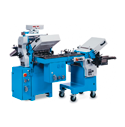To confirm that the parameters of processes/equipment used to manufacture the product comply with the specified requirements, manufacturers perform a validation.
Validation is a procedure that ensures a high degree of confidence in a specific process (equipment) consistently yielding the results that comply with the pre-defined criteria.
Validation demonstrates that the manufacturer is in full control of the production process.
According to GMP standard requirements the following items are subject to validation:
- production processes;
- analytical methods;
- processes of cleaning equipment, utilities, etc.;
- processes of rooms sanitary treatment, etc.;
- technological and laboratory equipment;
- engineering systems that directly affect the quality of semi-finished and finished product (supply of clean air, water, steam, inert gas, compressed air, etc.);
- clean premises and areas, cold rooms, etc.
The following items are not subject to validation:
- equipment that does not affect the quality of semi-finished or finished product;
- engineering systems that do not directly affect the product quality (power supply systems, etc.);
- general structural elements of buildings and premises;
- auxiliary computer systems that are not directly related to the production process.
Main validation steps are:
- qualification of design documentation (Design Qualification – DQ);
- Installation Qualification – IQ;
- Operational Qualification, OQ;
- Performance Qualification – PQ;
- production process validation (Process Validation - PV);
- Validation of Analytical Procedures – AV;
- Validation of Cleaning Processes – CV;
- qualification and validation of systems operation.
- Revalidation
 Qualification is the initial validation step intended to check and assess the design documentation and production conditions (equipment, engineering systems, room, etc.) in terms of compliance with the requirements of regulatory and technical documentation.
Qualification is the initial validation step intended to check and assess the design documentation and production conditions (equipment, engineering systems, room, etc.) in terms of compliance with the requirements of regulatory and technical documentation.
 Validation of processes is a validation step performed individually for each process using specimens from at least three batches of actual product in order to confirm that the process is repeatable and yields expected results during product manufacturing. Process validation is carried out for new production processes, in case of introducing modifications, and during revalidation.
Validation of processes is a validation step performed individually for each process using specimens from at least three batches of actual product in order to confirm that the process is repeatable and yields expected results during product manufacturing. Process validation is carried out for new production processes, in case of introducing modifications, and during revalidation.
Main types of validation are:
- prospective validation (before deliveries of manufactured product) is aimed at confirming correctness of specified production process parameters;
- concurrent validation (during mass production) consists in checking at least three consecutively produced drug lots against all the parameters specified in the validation report. After that conclusions are drawn on absence of deviations and compliance with the criteria; then the process is considered to be validated;
- retrospective validation is performed in the process of drug production and sales and includes examination of production reports for at least 10-30 drug lots against acceptance criteria and potential deviations.
 Validation requires thorough preparation and planning of various steps and stages. The validation program must be clearly defined and documented in the validation plan.
Validation requires thorough preparation and planning of various steps and stages. The validation program must be clearly defined and documented in the validation plan.
A validation plan must contain the following:
- validation aim;
- organization chart of validation activity;
- list of all rooms, systems, equipment and processes subject to validation;
- forms of protocols and reports;
- works completion planning and schedule;
- change control;
- reference to existing documents.
The aim of validation plan consists in:
- definition of scope, procedure and time frames for completion of actions to assess installation and performance of main process and auxiliary equipment;
- assessment of production processes conditions and parameters;
- assessment of analysis methods and obtaining a documented confirmation that the processes (equipment) used to make the product conform with their intended use and yield reliable and repeatable results.
The following documentation is used for validation planning:
- design documentation elaborated according to relevant procedures;
- acceptance and transfer documentation confirming completion of construction and installation and commissioning works;
- regulatory and technical documentation (manufacturer's monograph, procedures, specifications, certificates of compliance, etc.).
An essential planning component is drafting the forms of validation protocols, reports and procedures. All work must be carried out in a certain sequence according to regulatory and technical documents in force.
A specific feature of the validation process is involvement of staff from various company departments, as well as, if required, third-party organizations or experts.
Thus, validation provides a manufacturer with a documentary confirmation of the processes (equipment) compliance with the specified requirements. This significantly reduces the risk of mistakes, working time losses to identify and eliminate those mistakes and to introduce the appropriate corrections.










